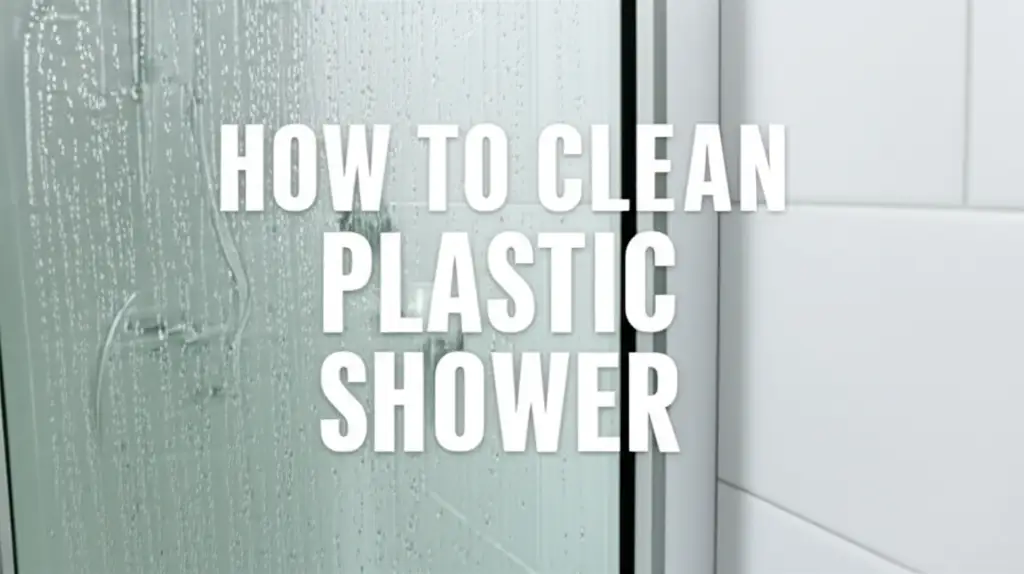· Home Cleaning · 17 min read
How To Clean Plastic Shower

Mastering Your Plastic Shower: A Deep Clean Guide
Do you look at your plastic shower and wish it sparkled like new? Many people struggle with keeping plastic shower enclosures clean. Over time, these surfaces collect soap scum, hard water stains, and unsightly mold. This makes your bathroom look dull and unclean.
Cleaning a plastic shower requires specific methods. You need to use the right products and techniques to avoid damage. Harsh chemicals or abrasive scrubbers can scratch or discolor plastic surfaces. This guide will walk you through effective ways to restore your plastic shower’s shine.
You will learn about preventative measures and deep cleaning strategies. We cover everything from daily care to tackling stubborn grime.
Takeaway: Restore Your Plastic Shower’s Shine
- Clean your plastic shower regularly with mild products to prevent buildup.
- Use gentle scrubbers to avoid scratches on plastic surfaces.
- Address specific issues like mold and hard water with targeted solutions.
- Improve ventilation to reduce moisture and inhibit mold growth.
- Maintain a consistent cleaning schedule for lasting sparkle.
Cleaning a plastic shower requires regular maintenance with mild cleaners like dish soap or vinegar to prevent buildup. For stubborn soap scum and mold, use specialized cleaners or a baking soda paste, scrubbing gently to restore shine without scratching the surface.
Understanding Your Plastic Shower: Materials and Vulnerabilities
Plastic showers are popular in many homes. They come in various forms, offering durability and affordability. Understanding the specific material of your shower helps you choose the best cleaning method. Using the wrong product can cause damage.
Common Plastic Shower Materials
Most plastic showers use acrylic or fiberglass. Acrylic is a smooth, non-porous plastic. It resists stains and scratches better than some other materials. Acrylic showers often have a shiny finish. Fiberglass showers use a resin reinforced with glass fibers. This material is lighter and often more affordable. Fiberglass can be more porous than acrylic. It may show scratches or stains more easily over time. Both materials are common in shower enclosures, tubs, and walls.
Why Plastic Needs Special Care
Plastic surfaces are sensitive to certain chemicals and abrasives. Ammonia-based cleaners, harsh solvents, or abrasive powders can dull, scratch, or even dissolve plastic. Scratches create tiny grooves where dirt, soap scum, and mold can hide. This makes the shower harder to clean later. Over time, improper cleaning can lead to permanent damage or discoloration. The material can become cloudy or yellow.
Identifying Your Shower Type
Most manufacturers specify the material of their shower units. If you are unsure, you can often tell by touch. Acrylic feels very smooth and warm. It has a high gloss. Fiberglass might feel slightly textured or less smooth. It often has a gel-coat finish that can be prone to cracking with age. Knowing your material helps you pick gentle, effective cleaners. Always test new cleaners on a small, hidden area first. This prevents potential damage to your plastic shower.
Why Your Plastic Shower Gets Dirty: Common Culprits
Plastic showers, like any bathroom surface, attract different types of grime. Understanding these common culprits helps you target your cleaning efforts. Each type of dirt requires a slightly different approach. Ignoring these issues makes your cleaning job harder.
Soap Scum Build-Up
Soap scum is a pervasive problem in showers. It forms when minerals in hard water mix with the fatty acids in soap. This combination creates a sticky, grayish film. This film clings to plastic surfaces, making them look dull. Liquid body washes can also contribute to soap scum, though traditional bar soap often leaves more residue. The more people use the shower, the faster soap scum builds. Regular scrubbing is essential to prevent its hardening.
Hard Water Stains
Hard water contains high levels of dissolved minerals. These minerals include calcium and magnesium. When water dries on plastic surfaces, it leaves behind these mineral deposits. These appear as white, chalky spots or streaks. Hard water stains are especially visible on darker plastic. Over time, these spots can become very thick and difficult to remove. They etch into the surface, making it feel rough. Using a water softener can help reduce hard water issues.
Mold and Mildew Growth
Plastic showers offer a warm, moist environment perfect for mold and mildew. These fungi thrive in damp conditions. Mildew often appears as a fuzzy, black or brown growth. Mold can be black, green, or even pink. These growths often start in corners, along seams, or wherever moisture collects. They not only look unpleasant but can also cause health problems. Poor ventilation makes mold and mildew worse. You can learn specific methods for removing these growths from your plastic surfaces. Clean mold off plastic to keep your shower safe and hygienic. Regular drying and proper air circulation are key preventative measures.
Essential Tools and Supplies for Cleaning Plastic Showers
Having the right tools makes cleaning your plastic shower much easier. It also protects your shower from damage. Avoid harsh scrubbers that can scratch delicate plastic surfaces. Using appropriate cleaners helps lift dirt without causing harm.
Gentle Cleaning Agents
You need cleaners that are tough on grime but gentle on plastic. Dish soap is an excellent starting point. A few drops of dish soap mixed with warm water create a mild, effective cleaner. For tougher stains, white vinegar is a fantastic natural option. It helps dissolve soap scum and hard water deposits. Baking soda also works well as a gentle abrasive paste. You can mix it with water or vinegar. For very stubborn issues, specialized non-abrasive bathroom cleaners designed for plastic or acrylic showers are available. Always check product labels to ensure they are safe for plastic. Learn how to specifically use vinegar for shower cleaning to maximize its effectiveness.
Scrubbing Tools
Choose soft scrubbing tools to protect your plastic shower. Microfiber cloths are ideal for wiping down surfaces. They absorb well and do not scratch. Soft sponges or non-scratch scrubbing pads are good for light scrubbing. For slightly tougher spots, a soft-bristled brush, like a dedicated shower brush or a toothbrush for tight corners, works well. Never use steel wool, abrasive scouring pads, or stiff-bristled brushes. These can cause permanent scratches that trap more dirt in the future. A squeegee is also a valuable tool. It removes water from surfaces after each use, preventing water spots and soap scum.
Protective Gear
Protecting yourself during cleaning is important. Wear rubber gloves to shield your hands from cleaning solutions. This prevents skin irritation. If you are using stronger cleaners, or if your bathroom has poor ventilation, consider wearing eye protection. A pair of safety glasses protects your eyes from splashes. Good ventilation is also a form of protection. Open windows or turn on the exhaust fan. This helps clear fumes and reduces moisture in the air. Staying safe makes the cleaning process more pleasant and effective.
Step-by-Step Daily and Weekly Cleaning for a Sparkling Plastic Shower
Consistent cleaning is the secret to a perpetually clean plastic shower. Daily and weekly routines prevent grime from building up. This saves you from difficult deep cleaning jobs later. Small efforts regularly yield great results.
Post-Shower Rinse and Wipe
Make it a habit to quickly rinse your plastic shower after each use. Hot water helps wash away soap residue. Then, use a squeegee to remove excess water from the walls and door. This simple step is highly effective at preventing soap scum and hard water stains. If you do not have a squeegee, a clean microfiber cloth works well. Just wipe down the surfaces quickly. This small daily action significantly reduces mineral and soap buildup. It keeps your plastic shower looking cleaner longer.
Weekly Maintenance Routine
Once a week, give your plastic shower a more thorough cleaning. Start by spraying the entire surface with a mild, all-purpose bathroom cleaner. You can also use a mixture of equal parts white vinegar and water. Let the cleaner sit for 5-10 minutes. This allows it to break down grime. Then, use a soft sponge or microfiber cloth to wipe down all surfaces. Pay attention to the walls, floor, and shower doors. Rinse thoroughly with water. This weekly scrub keeps your shower fresh. It prevents the need for intense deep cleans. For specific guidance on cleaning surfaces like the walls, refer to our guide on how to clean plastic shower walls.
Preventing Future Buildup
Prevention is key to an easy cleaning routine. Improve ventilation in your bathroom. Open windows after showering or run an exhaust fan for at least 15-20 minutes. This reduces humidity. Less humidity means less mold and mildew growth. Consider using liquid soap or body wash instead of bar soap. Liquid products often leave less residue. You can also apply a plastic-safe protective spray. These sprays create a barrier that repels water and soap scum. Reapplying them periodically helps maintain a clean surface. These preventative steps make your weekly cleaning faster and more effective.
Deep Cleaning Your Plastic Shower: Tackling Tough Stains
Sometimes, regular cleaning is not enough. Tough stains like heavy soap scum, significant hard water deposits, or stubborn discoloration require a deeper approach. Do not worry; your plastic shower can look new again with the right methods.
Combating Stubborn Soap Scum
Heavy soap scum can be challenging. Start by creating a paste of baking soda and a small amount of water. Apply this paste directly onto the soap scum areas. Let it sit for 15-30 minutes. The baking soda acts as a gentle abrasive and helps lift the grime. Then, use a soft-bristled brush or a non-scratch scrub pad. Gently scrub the affected areas in circular motions. Rinse thoroughly with warm water. For extra power, you can spray white vinegar over the baking soda paste. This creates a fizzing action that helps break down the scum further. Repeat if necessary until the scum disappears.
Eradicating Hard Water Deposits
Hard water stains can be persistent. Vinegar is your best friend here. Fill a spray bottle with undiluted white vinegar. Spray it generously onto all hard water spots. For very thick deposits, you can soak paper towels in vinegar and stick them to the affected areas. Let them sit for several hours or even overnight. The acidity of the vinegar dissolves the mineral buildup. After soaking, scrub gently with a soft brush or sponge. Rinse well. If vinegar alone is not enough, you can try a commercial descaling cleaner specifically formulated for plastic. Always check the label and test a small area first. For detailed help on specific stains, explore tips on how to clean stains on plastic.
Addressing Discoloration and Grime
Plastic showers can become discolored over time, especially the bottom area. This is often due to a combination of grime, mildew, and mineral deposits. To address the dirty bottom of your shower, a thorough cleaning is required. Cleaning the bottom of a shower often means tackling concentrated buildup. Start with the baking soda and vinegar paste method. Apply it generously to the discolored areas. Let it sit for an hour. Then, scrub with a soft brush. For persistent discoloration, a mild bleach solution can be used. Mix one part bleach with ten parts water. Apply it carefully to the discolored area with a cloth or sponge. Let it sit for no more than 10-15 minutes. Rinse thoroughly. Always ensure proper ventilation when using bleach. Test bleach on a small, hidden spot first, as some plastics can react poorly.
Natural and Chemical Solutions for Specific Plastic Shower Problems
You have many options for cleaning your plastic shower. Some people prefer natural solutions. Others need the power of chemical cleaners for tough jobs. Knowing when to use each helps you clean effectively and safely.
Harnessing Vinegar and Baking Soda
White vinegar is a cleaning powerhouse for plastic showers. Its acidity dissolves soap scum and hard water stains. You can use it undiluted in a spray bottle. Spray it on all surfaces and let it sit for 15-30 minutes before scrubbing. Baking soda is a gentle abrasive and odor absorber. You can make a paste with baking soda and water. Apply this paste to stubborn spots. Scrub gently with a soft brush. For extra cleaning power, spray vinegar over the baking soda paste. This creates a fizzing action that helps lift grime. Rinse all surfaces thoroughly after using these natural cleaners. They are safe for most plastic types and leave no harsh fumes.
Power of Hydrogen Peroxide
Hydrogen peroxide is an excellent natural disinfectant. It works well on mold and mildew. For areas with mold, spray 3% hydrogen peroxide directly onto the affected spots. Let it sit for 10-15 minutes. Then, scrub with a soft brush or sponge. Hydrogen peroxide effectively kills mold spores without harsh chemicals. It also helps brighten discolored plastic. You can use it as a follow-up after an initial cleaning. Always rinse the area well after application. This ensures no residue remains. Hydrogen peroxide is a safer alternative to bleach for many cleaning tasks.
When to Use Commercial Cleaners
Sometimes, natural cleaners are not enough for very old or deeply ingrained stains. Commercial shower cleaners are an option for these situations. Look for products specifically labeled “safe for acrylic” or “safe for plastic showers.” Avoid cleaners with abrasive particles, strong acids, or solvents like acetone. These can damage the plastic. Follow the product instructions carefully. Always test the cleaner on a small, hidden area first. This checks for any adverse reactions like discoloration or etching. Using commercial cleaners should be a last resort for routine cleaning. They are best saved for occasional deep cleaning of very stubborn issues.
Advanced Cleaning Methods for Heavily Stained Plastic Showers
Sometimes, a plastic shower accumulates severe stains. These might include deep yellowing or extremely persistent mold. Standard methods may not be enough. For these situations, advanced techniques are needed. These methods require extra caution.
Targeted Stain Removal with Stronger Agents
For very tough stains, targeted applications of stronger agents can work. Lemon juice, a natural acid, can help brighten yellowed plastic. Apply fresh lemon juice to the stain. Let it sit in direct sunlight for a few hours. The sun’s UV rays combined with the acid can bleach the stain. Rinse thoroughly afterward. For severe soap scum or mineral deposits that vinegar cannot conquer, oxalic acid-based cleaners (found in some rust removers) can be effective. However, these are potent. They must be used sparingly and rinsed immediately. Always wear gloves and ensure excellent ventilation. Test on an inconspicuous area first.
Understanding Bleach Application (with Caution)
Bleach can be very effective for severe mold or deep discoloration. However, it requires extreme caution on plastic. Bleach can cause some plastics to yellow or degrade over time, especially with frequent use. If you decide to use bleach, create a very dilute solution: one part bleach to ten parts water. Apply it with a sponge or cloth to the stained area. Let it sit for no more than 5-10 minutes. Do not let it dry on the surface. Rinse the area thoroughly with plenty of water immediately after. Ensure the bathroom is well-ventilated. Never mix bleach with other cleaners, especially ammonia or vinegar, as this creates dangerous fumes. For more comprehensive guidance on using bleach in your shower, consult how to clean shower with bleach. Use this method only as a last resort for truly intractable stains.
Commercial Restoration Products
For extreme cases, specialized commercial products exist. These are designed to restore severely stained or dull plastic showers. Some products are polishing compounds that can remove light scratches and restore shine. Others are heavy-duty cleaners that target specific problems like extensive mold or rust stains. Read reviews and product descriptions carefully. Ensure the product is explicitly safe for your type of plastic (acrylic or fiberglass). These products often come with specific application instructions. They may require buffing or extended dwell times. Always follow manufacturer guidelines. Using these products can be more expensive. However, they can save a shower that seems beyond hope.
Maintaining Your Plastic Shower: Long-Term Care Tips
Keeping your plastic shower clean is an ongoing effort. Regular maintenance ensures its longevity and appearance. A few simple habits can make a big difference. These tips help prevent future cleaning headaches.
Proper Ventilation is Key
Moisture is the primary enemy of a clean shower. It encourages mold and mildew growth. Always run the exhaust fan during and after showering. Leave it on for at least 15-20 minutes after you finish. If you do not have an exhaust fan, open a window or the bathroom door. This allows moist air to escape. Good air circulation dries surfaces faster. A dry shower is less likely to harbor fungi. Consider installing a dehumidifier in your bathroom if moisture remains a persistent issue. This proactive step significantly reduces humidity levels.
Regular Squeegee Use
A squeegee is a simple yet powerful tool. Use it to wipe down shower walls and doors after every shower. This removes water droplets before they dry and form hard water spots or soap scum. It takes only a minute or two. This small effort prevents the majority of future buildup. If you do not have a squeegee, a microfiber cloth works similarly. The goal is to remove standing water. This single habit can cut your deep cleaning time by more than half.
Choosing the Right Products
Be mindful of the products you bring into your shower. Stick to liquid soaps and body washes over bar soaps. Bar soaps often contain ingredients that react with hard water to form more soap scum. Select shampoos and conditioners that rinse clean. Avoid products with dyes that can stain your plastic. When buying cleaning supplies, always choose non-abrasive formulas. Look for labels that say “safe for acrylic,” “safe for fiberglass,” or “non-abrasive.” Store cleaning supplies properly. Keep them out of reach of children and pets.
Annual Deep Dive
Even with daily and weekly care, an annual deep dive is beneficial. This is a chance to thoroughly inspect your plastic shower. Look for any areas that might be developing issues. Remove and clean shower heads to clear mineral buildup. Inspect grout lines if your plastic shower includes them. Replace old, worn-out scrubbing tools. This annual review helps catch problems early. It ensures your plastic shower remains sparkling and hygienic for years to come.
Frequently Asked Questions
Can I use bleach on my plastic shower?
You can use bleach on plastic showers, but do so with extreme caution. Use a very dilute solution (1 part bleach to 10 parts water). Apply it to stained areas for no more than 5-10 minutes. Rinse thoroughly immediately. Bleach can cause some plastics to yellow or degrade with frequent or undiluted use. Always ensure proper ventilation and never mix bleach with other cleaners.
How often should I clean my plastic shower?
For best results, rinse and squeegee your plastic shower daily after each use. Perform a light cleaning with a mild cleaner weekly to prevent buildup. A deep clean should be done monthly or as needed, depending on usage and water hardness. Consistent maintenance prevents major cleaning jobs.
What causes yellowing in plastic showers?
Yellowing in plastic showers usually results from a combination of factors. These include prolonged exposure to hard water, soap scum, residual cleaning products, and sometimes UV light degradation. Certain types of mold or mildew can also contribute to discoloration. Regular cleaning helps prevent this common issue.
How do I prevent mold in my plastic shower?
Preventing mold is key. Always ensure good ventilation by running an exhaust fan during and after showers. Wipe down surfaces with a squeegee or cloth to remove excess moisture. Keep the bathroom dry. Consider using a daily shower spray that inhibits mold growth. Address any leaks promptly.
Are abrasive cleaners safe for plastic showers?
No, abrasive cleaners are generally not safe for plastic showers. They can scratch the surface of acrylic or fiberglass. These scratches dull the finish and create tiny crevices where dirt, soap scum, and mold can accumulate, making future cleaning harder. Always opt for soft cloths, sponges, and non-abrasive cleaning solutions.
Conclusion
A clean plastic shower enhances your bathroom’s appeal and hygiene. We have covered various strategies to achieve this, from daily upkeep to deep cleaning tough stains. Remember that consistent care is your best defense against dirt and grime. Regularly rinsing and squeegeeing your plastic shower prevents most issues. Using gentle cleaners like vinegar or baking soda protects your plastic surfaces.
Tackling stubborn mold, soap scum, or hard water stains requires a bit more effort. However, with the right tools and techniques, your plastic shower can look new again. Proper ventilation and smart product choices also play a big role in long-term maintenance. Embrace these simple habits to keep your plastic shower sparkling clean. A clean shower makes your daily routine more pleasant. Start your journey to a cleaner shower today.
- plastic shower cleaning
- shower maintenance
- bathroom cleaning
- mold removal
- soap scum
- hard water stains
- DIY cleaning




